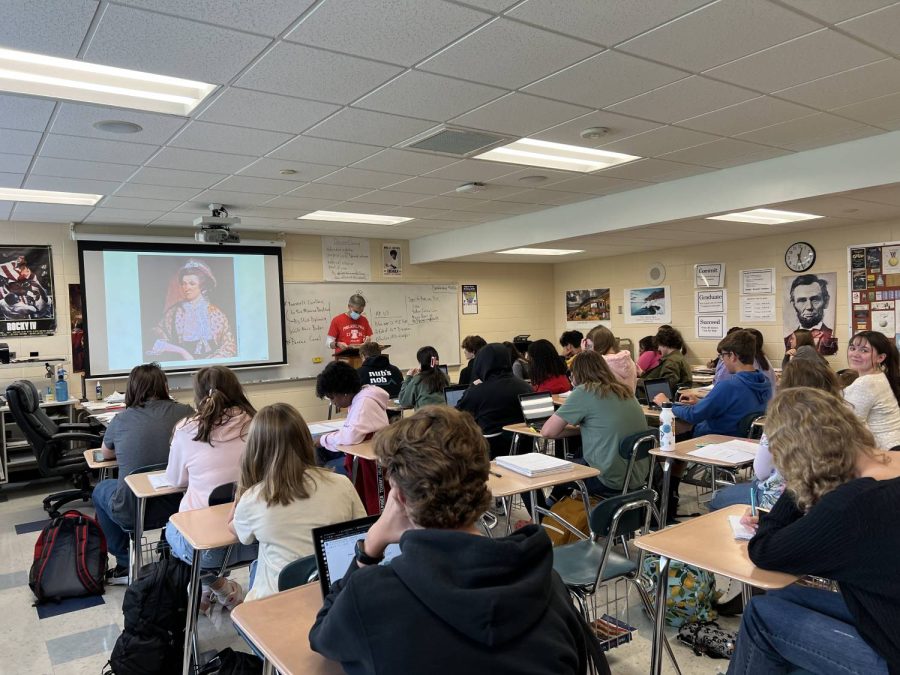Overflowing AP classes and continuing lack of diversity causes problems for teachers and students
Credit: Eleanor Cook
Matthew Porco’s fourth hour APUSH class, finally below the 37-student limit. Although Porco was able to remove desks from the room once several students left the class, the class is still crowded.
September 27, 2022
It’s the first day of school and you’re walking into your AP class. You’ve taken one or two AP classes before, and you’ve never had problems with classrooms being too full. But when you walk into the class, the front of the room is barely visible. The room is so full of students that you aren’t even able to sit down.
For many AP students at Loy Norrix, this was the reality of the first day of school. Across the United States, the enrollment rates in AP classes have been steadily increasing for the past decade, with the Student Research Foundation reporting a 65% increase in student testing between 2008 and 2018. For Norrix, the number of AP students is at an all-time high.
One of the teachers affected by the increasing number of AP students is history teacher Matthew Porco. On the first day of school, 42 students were on the roster for his AP United States History course.
“I’ve had classes in the 30s before. I’ve had classes of 35 before. I’ve never had a class that started the year at 40,” said Porco.
Sophomore Sofia Bogard describes her expectations going into Porco’s APUSH class.
“I guess I was thinking it should be a relatively small class… I didn’t think everyone was wanting to take it,” Bogard said.
The reality of the first day, however, did not match these expectations at all. According to Bogard, the class was so full that some students were forced to sit on the counter lining the back of the room.
Math teacher Adam Hosler is also experiencing large class sizes, most noticeably in his third hour AP Calculus class. As of Sept. 15, the class had 38 students — only one student had opted-out of the class since the beginning of the year. Like Porco, his normal class size ranges around 35 students, which means that having more than 37 students (which is the legal maximum for a KPS classroom) means that there aren’t enough desks for everyone.
While having larger AP classes means that students are interested in challenging themselves and learning more, providing quality AP courses becomes much harder for teachers when their classes are filled to maximum capacity or beyond.
“There are a lot of days where it’s fine, and the difference between 37 and 27 is just more of the physical crowding,” said Porco, “but when it comes time where we’re going to want some one-on-one help and interaction, it becomes more difficult the bigger the class is.”
In an AP Calculus class, similar problems come up with larger classes. Hosler agreed that having larger classes makes it difficult to give students individual help and attention. Students are also less likely to participate when there are more people in the class.
“I think sometimes students in bigger groups just don’t ask questions because it’s a big class and they don’t want to feel singled out,” Hosler said.
Another problem becoming even more obvious with increasing class sizes is the lack of diversity in AP classes.
Although College Board is no longer publicizing breakdowns of test scores by ethnicity and race, Education North Carolina asserts that non-Asian students of color continue to be under-represented in AP classes, while white and Asian students are over-represented.
For Norrix, which has no majority race in its student body, these numbers prove how inaccessible AP courses can be for non-Asian people of color and other marginalized groups.
“I don’t think AP classes reflect the diversity of the student body, and I think that’s something we should continue to work on,” Porco said, “I think if you started putting prerequisites [on AP courses]… it would just close it off to a large group of people.”
Hosler shared similar sentiments about the population of his AP Calculus class, though he observed a higher degree of diversity than Porco.
“I mean, I wouldn’t say it’s necessarily reflective of the entire student body… but it’s not homogenous,” Hosler said, “There’s a pretty good mix.”
Despite the challenges of balancing the number of students in AP courses, teachers’ priorities are keeping students in their AP classes.
According to the district-set rules concerning class size, counselors had until Sept. 21 to make sure that all AP classes were down to their 37-student limit. With the deadline having already passed, the most effective methods of reducing class sizes have been encouraging students to opt-out of AP courses or moving them to different periods.
For teachers and students, however, the large classes still create problems with the quality of education the students receive.












